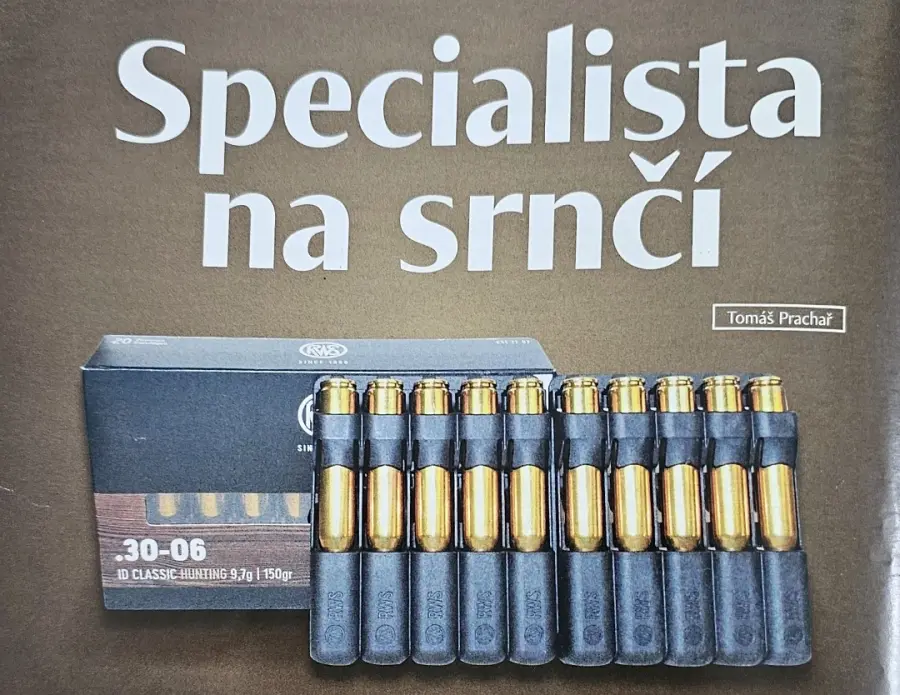Specialist for roe deer

We tested the ID Classic bullet from RWS ammunition, which is expected to be an ideal choice for hunting roe deer and other lighter game. But how did it perform in practice at the range and in the field?
The RWS ID Classic is not only an interesting bullet at first glance due to its unusual design, but it also has a compelling history. This dates back to the late 1910s and early 1920s, when Brenneke introduced the TIG bullet (Torpedo Ideal Geschoß) to the market, featuring a distinctive torpedo-like shape, which is also reflected in its name. The bullet gained popularity among hunters, and Brenneke continues to manufacture it to this day. In 1972, production under license was granted to RWS, which began loading it into cartridges from its portfolio. This collaboration continued until 2006, when Brenneke refused to extend the license. RWS, however, continued production, merely renaming the bullet to ID Classic. A legal dispute followed, with a somewhat behind-the-scenes settlement. The outcome is that RWS can continue producing the bullet. Hence, some hunters still refer to it as the TIG bullet, and the frequent question remains as to which one is superior. However, we'll leave that debate aside and focus on what this century-old bullet can offer today's hunters.
Two Cores
At the time of its development, this was a structurally bold bullet, featuring two cores. Both are made of a lead alloy, but while the front core is soft, the rear core exhibits significantly higher cohesion and is firmly bonded to the jacket. The jacket itself is made of soft steel coated with a thick layer of nickel, designed to reduce barrel wear. The jacket tapers towards the tip to control deformation. This is a semi-jacketed bullet with an exposed front core. The bullet tip is shaped somewhere between a sharp "spitzer" and a rounded RN (Round Nose). However, due to its shape and relatively low sectional density, the bullet does not achieve particularly high ballistic coefficient values. For example, in the .308 caliber, the BC is a modest 0.303. On the jacket, there is a distinct cutting edge, a crimping groove where the cartridge case can be crimped during reloading, and the bullet ends in an unusually shaped "torpedo-like" rear, designed to provide additional stabilization for long-range shooting.
The concept behind the dual-core design is that upon passing through tissue, the front soft core readily deforms, transferring a sufficient amount of energy to the target, while the rear core remains bonded to the jacket and, due to its weight, drives the bullet deeper into the vital zone. The bullet is available in a relatively limited range of options, specifically in .308 caliber with a weight of 150 grains, the 8mm (.323) version weighing 198 grains, and the 7mm (.284) version available in two weights: 162 and 177 grains. Not a wide selection, but with the exception of .243 and .264 calibers, most major calibers are represented. However, it's a bit of a pity, as the ID Classic is particularly suited for lighter game, and the combination with smaller calibers makes perfect sense. RWS offers both standalone bullets and factory ammunition, which comes in a dedicated box. The bullet is designed for hunting medium and lighter game, ideal for roe deer and lighter wild boar. For large wild boar or trophy deer and mouflon, it might not be the best choice.

While this is not explicitly a "sniper" bullet, our shooting test showed that it definitely has the potential for more than decent accuracy.
Heading to the Range
I had the opportunity to practically test the .308 caliber variant, weighing 150 grains, which I reloaded into .308 Win cartridges. When it comes to reloading, there are no significant challenges. The only thing to keep in mind is that the neck contact area is relatively short, slightly limiting the options for optimal seating depth adjustment. The bullet tip does not deform during reloading or normal handling. I tested three configurations using two different powder charges of Lovex D073-06 and two seating depths. The best accuracy was achieved with a 46.5-grain powder charge combined with a standard seating depth of 71.1 mm, which in combination with the chamber of my rifle resulted in a "jump" of just over 1 mm. According to the output from the GRT program, the bullet achieved a velocity of 797 m/s and an energy of 3,086 J. Unfortunately, the weather at the range did not allow for real-world velocity measurements, but based on experience with this powder, I estimate the velocity would be slightly higher than what the program indicates.
For the tests, I used a Ruger American Predator rifle with a 457 mm (18 inches) barrel, mounted on a heavy tripod and with the stock supported by a shooting bag. For comparison, with highly tuned ammunition, I have been able to achieve a 5-shot group measuring 18 mm at 100 meters from this rifle. How did the RWS bullet perform in comparison? Quite impressively! The group at a distance of 75 meters was within 19 mm (measured center-to-center, with five shots and excluding the worst shot). This would translate to about a 22-23 mm group at a standard distance of 100 meters.
It’s important to note that with more extensive tuning and possibly a better-quality powder, slightly improved results could likely be achieved. Personally, I believe the bullet paired with the rifle exceptionally well, but of course, this might not hold true for everyone. The behavior during shooting was normal (considering the shorter barrel). It's worth mentioning that, thanks to the cutting edge, the bullet holes in the paper were unusually cleanly "cut out." However, as hunters, we are less concerned with paper and more focused on how the bullet performs on game. That's why we headed into the field.

Thanks to its special design, the bullet expands readily even at lower impact velocities when used on lighter game.
Factory "IDs"
As I hinted in the text, RWS, in addition to offering standalone bullets, also offers factory-loaded cartridges. Specifically, these include 7x57 mm, 7mm Rem Mag, 7x64 mm, 7x65mmR, .308 Win, .30-06, 8x57 JS, and 8x57 JRS. This selection will especially please hunters who favor classic Central European calibers, though it may not appeal as much to fans of more popular cartridges like the 6.5 mm. These cartridges are generally regarded as straightforward and high-quality (though not exactly top-tier) ammunition. According to the manufacturer, the cartridges deliver standard performance for their respective calibers. They neither disappoint nor overly impress, which is also reflected in feedback regarding accuracy. Regarding price, for example, the 7x57 mm cartridge sells for 73.8 CZK per round in a box of 20 cartridges (zbrane-tobiasek.cz). The price increases to about 80 CZK per round for the 8x57 JRS.

Factory 7x57mmR ammunition from RWS, loaded with a 162 gr ID Classic bullet.
Hunting with the "Classic"
In general, this is a bullet that falls into the softer spectrum, and even its advertised cohesion has its limits. If you shoot something large and/or tough with it, the bullet will likely fragment. At standard velocities, the ID Classic behaves similarly to a typical semi-jacketed bullet. At higher velocities, upon impact, it tends to "soften" somewhat and start fragmenting. On the other hand, it can be praised for behaving correctly at lower velocities and when used on appropriately sized game, exhibiting proper deformation.
There was nothing left to do but to verify these claims in actual hunting practice. Using the aforementioned .308 Win cartridge configuration, I harvested a sika hind weighing around 30 kg. This was almost an ideal candidate for the bullet to excel. The shot was taken at a distance of just under 180 meters. With a rough calculation, the impact velocity should have been somewhere around 635 m/s. The shot was placed just behind the shoulder due to the animal's position. The bullet passed through the chest, hitting the heart and lungs, and resulted in a complete pass-through. The animal collapsed almost textbook-style on the spot, and by the time I reached it, it showed no signs of life. Judging the amount of blood at the scene is difficult, as the entry wound was nearly invisible and showed little blood, while the exit wound would have likely left some noticeable trail. The level of tissue damage I would rate as slightly above average. The exit side was more bruised, and the exit wound was somewhat "violent." However, upon field dressing, I found no bullet fragments.

In the practical hunting test, the animal dropped on the spot, but at the cost of slightly higher meat damage.

The RWS ID Classic bullet in .308 caliber and 150 gr, displayed in all its characteristically shaped beauty.
It is important to emphasize that one harvested animal does not provide enough data to draw general conclusions, but the results do give a rough indication. If I summarize the opinions of those with more extensive experience with this bullet, its terminal performance on appropriately sized game is rated very positively, even in cases of slightly less well-placed shots. The animal typically drops on the spot or falls close to the point of impact. Whether the bullet passes through or not varies. When it comes to meat damage, opinions differ greatly. Some appreciate the minimal bruising, while others use terms like “brutal devastation,” which is likely very dependent on the impact velocity. For larger game, the bullet quickly loses its effectiveness, and for the sake of the game, it’s better not to push it.
Overall, the bullet can be rated as a good choice for hunting lighter game, especially roe deer or young wild boar, and of course for any kind of pest or small game. However, many hunters may find its lack of versatility for larger game a drawback. Furthermore, the bullet cannot be strongly recommended for use with high-velocity cartridges due to the increased risk of fragmentation. Its ballistic coefficient and sectional density are not particularly impressive, and finally, we must also mention the question of price. This bullet falls in the higher price range, costing between 32-37 CZK per bullet, depending on the caliber (sold in boxes of 50). In our tested variant, the .308" / 150 gr version cost 33.5 CZK per bullet. This is quite expensive, especially compared to other bullets of similar purpose. For example, a Nosler Ballistic Tip Hunting .308" / 150 gr costs around 21 CZK per bullet. Based on my experience, I would rate the Nosler slightly better in all parameters, and it is a more versatile bullet that can also be used on larger wild boar. This is something the ID Classic cannot claim.
The RWS ID Classic bullet can be purchased at STROBL.cz s.r.o. More information is available at strobl.cz, or on the manufacturer’s website at rws-ammunition.com.
Photo Sources: Author’s archive, manufacturer materials
Author: Tomáš Prachař
The article was originally published in the magazine Lovec by Extra Publishing.
Pros / Cons
+ Decent accuracy
+ Long-proven design over decades
- Price-to-performance ratio is not the best
- Low ballistic coefficient
- Not suitable for larger game

.308 Win cartridge reloaded with an ID Classic bullet compared to a simple military FMJ bullet.








